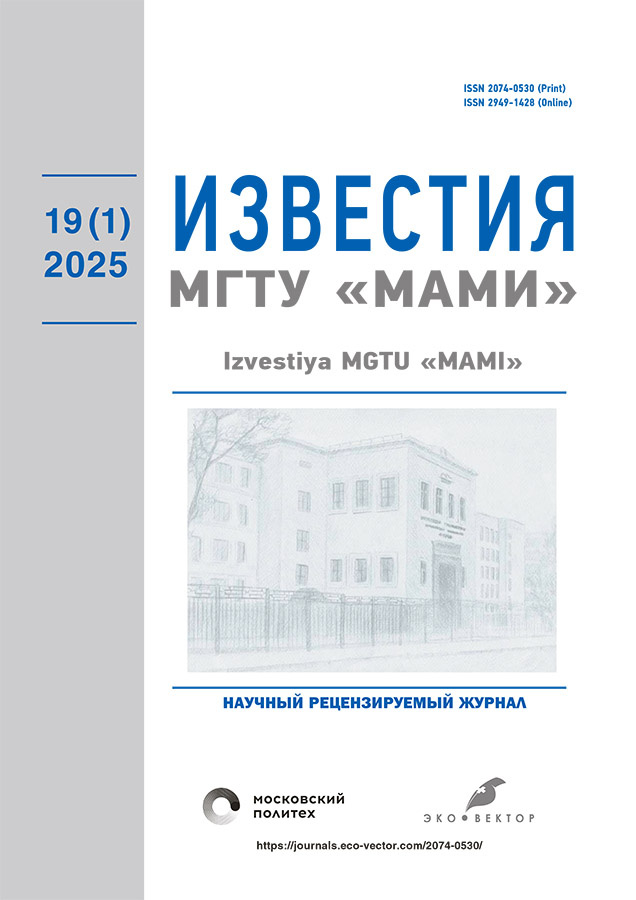Study of vibrational intensity of a centrifugal disc pump
- 作者: Lomakin O.D.1, Cheremushkin V.A.1
-
隶属关系:
- Bauman Moscow State Technical University
- 期: 卷 19, 编号 1 (2025)
- 页面: 369-378
- 栏目: Hydraulic and pneumatic systems
- URL: https://journals.eco-vector.com/2074-0530/article/view/660922
- DOI: https://doi.org/10.17816/2074-0530-660922
- EDN: https://elibrary.ru/OKOKHU
- ID: 660922
如何引用文章
详细
Background: Pumps with increased noise, vibration and harshness (NVH) requirements are in high demand in various fields of both civil and military equipment, especially underwater, due to stricter standards of sound pollution and the development of vehicle tracking systems. Disc pumps are one of the “quietest” pumps, due to their simple design and the absence of elements that cause eddy formation, but at the same time they ensure less pressure than, for example, vane pumps, which is why the former have not been studied in detail at the moment. Despite this, these machines require optimization, design innovations and deeper analysis in the field of vibrational intensity reduction.
Aim: Study of vibrational intensity of a disc pump using hydrodynamics and solid-state modeling, optimizing the geometry of the flow part to achieve continuous flow.
Methods: The calculation is a combination of computational fluid dynamics and computer-aided design, was performed in the Simcenter STAR-CCM+ software package, the simulation included unsteady conditions, the Detached Eddy Simulation (DES) turbulence model was selected for hydrodynamics, vibrational dampers were modeled. The HEEDS software is used for optimization.
Results: A 3D model of the entire pump, a vibration acceleration spectrogram, and a velocity field in the optimized flow part were obtained.
Conclusion: The practical value of the study lies in the obtained qualitative and quantitative data on the vibrational intensity of disc pumps, as well as in the correct body of mathematics for optimizing the geometry of the flow part to achieve non-cavitating flow in the flow part and maximum hydraulic efficiency, and, as a result, to achieve better noise behavior of the pump.
全文:
作者简介
Oleg Lomakin
Bauman Moscow State Technical University
Email: Malhanus@mail.ru
ORCID iD: 0009-0001-0295-6829
SPIN 代码: 8145-4486
engineer of the Hydromechanics, Hydraulic Machines and Hydropneumoautomatics Department
俄罗斯联邦, MoscowVyacheslav Cheremushkin
Bauman Moscow State Technical University
编辑信件的主要联系方式.
Email: vcheremushkin@bmstu.ru
ORCID iD: 0009-0006-7832-3952
SPIN 代码: 3708-7709
Cand. Sci. (Engineering), junior research associate of the Hydromechanics, Hydraulic Machines and Hydropneumoautomatics Department
俄罗斯联邦, Moscow参考
- Pokrovsky BV. Stands for complex vibroacoustic studies of centrifugal pumps. Proceedings of the WIGM XXXIV. 1964:79–101. (In Russ.)
- Pokrovsky BV, Yudin EYa. The main features of noise and vibration of centrifugal pumps. Acoustic Journal. 1966;12(3):355–364. (In Russ.)
- Pokrovsky BV, Rubinov VYa. The effect of discharge on the vibro-acoustic characteristics of a centrifugal pump. Proceedings of VNIIGIDROMASH. 1970;(40):84–102. (In Russ.)
- Pokrovsky BV. Noise and vibration of centrifugal pumps and measures to reduce them. Proceedings of VNIIGIDROMASH. 1971;(41):118–132. (In Russ.)
- Pokrovsky BV, Rubinov VYa. On the calculation of vibration levels of centrifugal pumps. Proceedings of VNIIGIDROMASH. 1971;(42):146–151.
- Pokrovsky BV. Laws of similarity of vibration-noise characteristics of centrifugal pumps. Proceedings of VNIIGIDROMASH. 1973;(45):50–63. (In Russ.)
- Rubinov VYa. Investigation of the effect of discharge devices on the vibro-acoustic characteristics of centrifugal pumps. Abstract of the 1975 dissertation. P. 24. (In Russ.)
- Pokrovsky BV, Rubinov VYa. The influence of the number of blades of the impeller and the guide device on the vibro-acoustic characteristics of centrifugal pumps. Proceedings of VNIIGIDROMASH. 1976;(46):71–86. (In Russ.)
- Zotov BN. Investigation of hydrodynamic sources of vibrations of a centrifugal pump. Power Engineering. 1974;(2):26–32. (In Russ.)
- Korben F. Vibration monitoring: Translated from English. Vibration monitoring. 1976;7(7):91. (In Russ.)
- Privalov VV. Dynamic properties of hydrostatic support systems of technological equipment and means of their correction. Russian Academy of Sciences Institute of Problems of Machine Science, Saint Petersburg, 2000. (In Russ.)
- Cheremushkin VA, Lomakin VO. Modeling of the operation of a disc pump with the wall roughness consideration. Izvestiya MGTU «MAMI». 2023;17(2):157–164. doi: 10.17816/2074-0530-321862 (In Russ.)
- Ogurtsov SV, Mikheev KG, Pushkarev VV. The use of conjugate calculation methods for assessing the vibration activity of pumps. Pumps. Turbines. Systems. 2022;3(44):96–107. EDN: XUHBCQ
补充文件

















